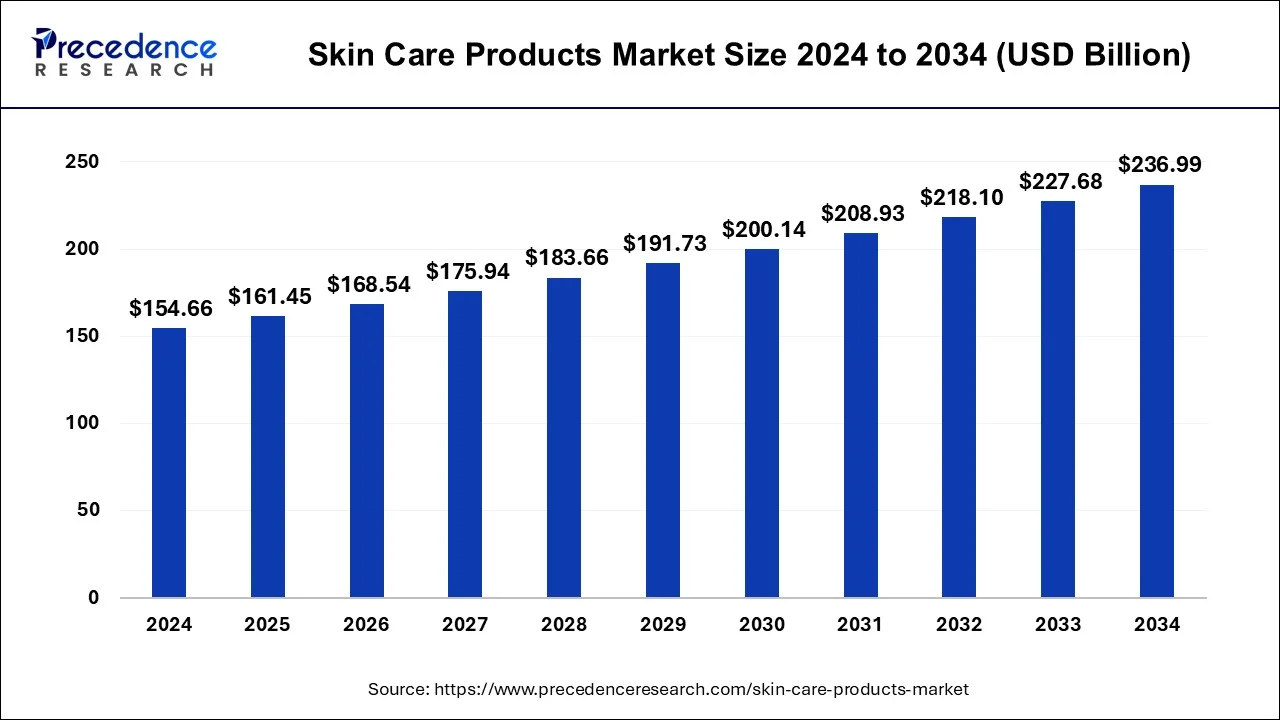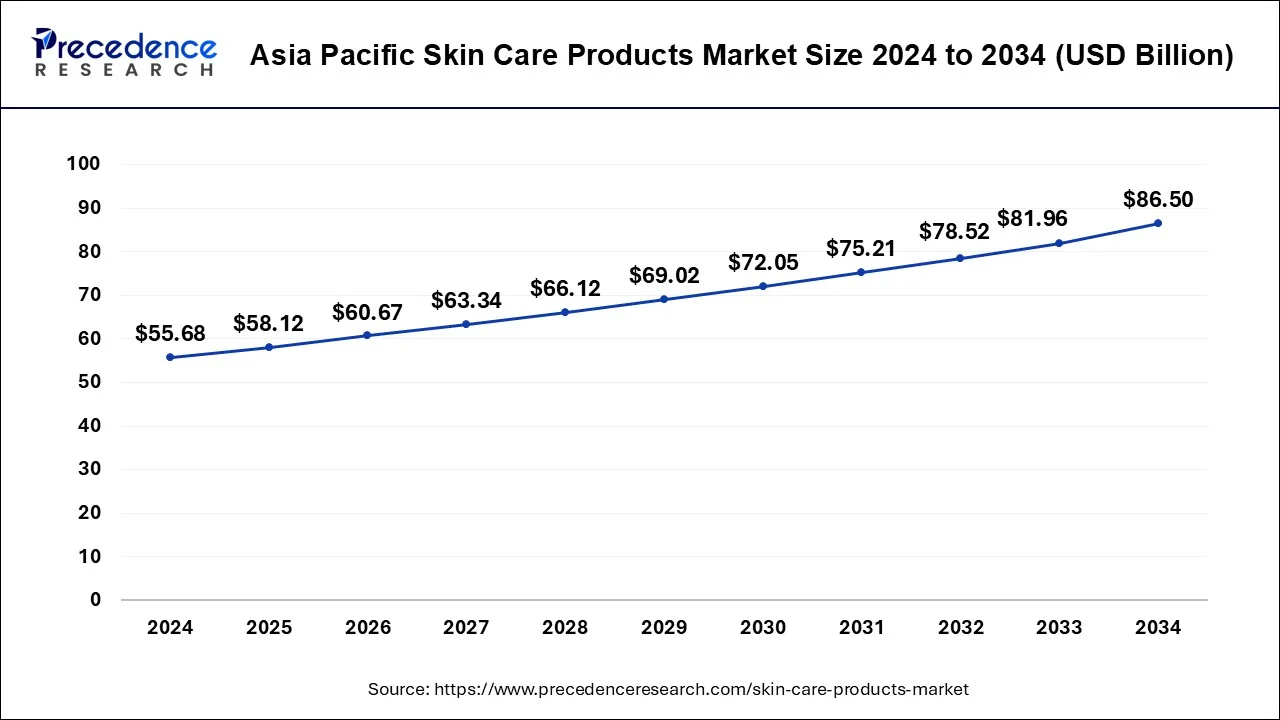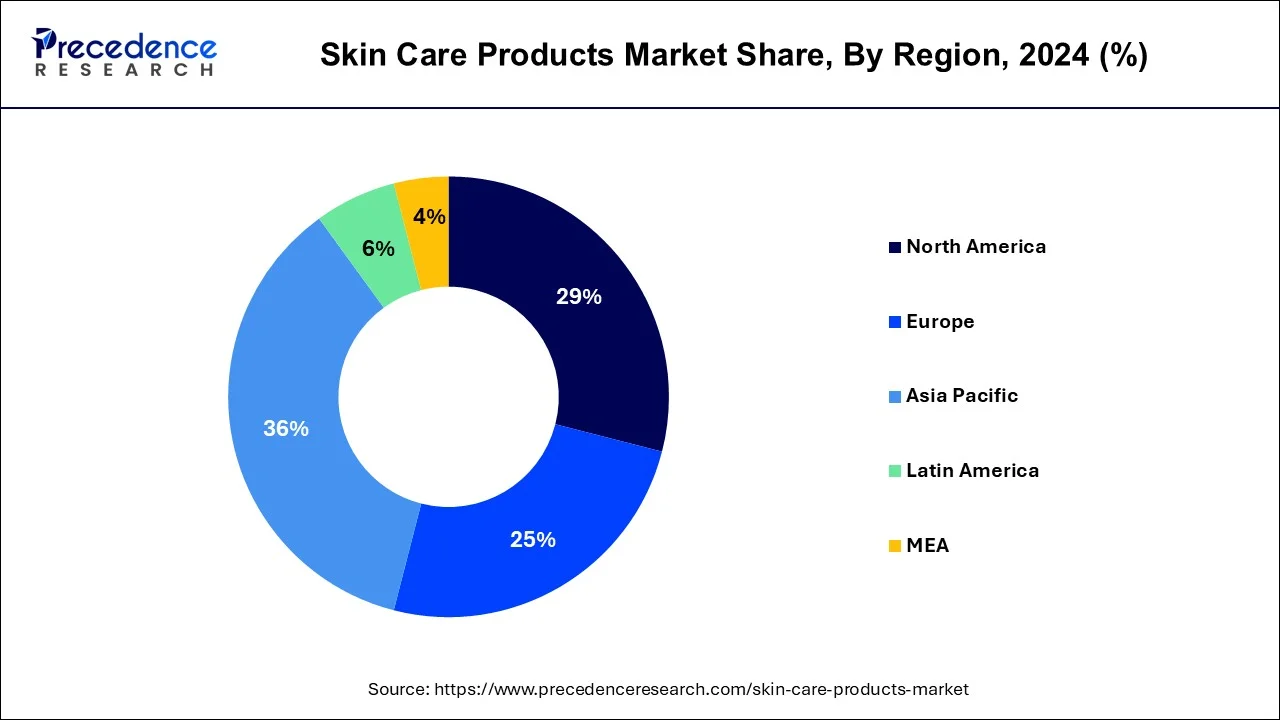September 2024
The global skin care products market size is calculated at USD 161.45 billion in 2025 and is forecasted to reach around USD 236.99 billion by 2034, accelerating at a CAGR of 4.36% from 2025 to 2034. The Asia Pacific skin care products market size accounted for USD 58.12 billion in 2025 and is expanding at a CAGR of 4.50% during the forecast period. The market sizing and forecasts are revenue-based (USD Million/Billion), with 2024 as the base year.
The global skin care products market size was estimated at USD 154.66 billion in 2024 and is predicted to increase from USD 161.45 billion in 2025 to approximately USD 236.99 billion by 2034, expanding at a CAGR of 4.36% from 2025 to 2034. The overall growth of the global skincare products market is driven by increased spending on personal care products across the globe.

The Asia Pacific skin care products market size was valued at USD 55.68 billion in 2024 and is expected to reach USD 86.50 billion by 2034, growing at a CAGR of 4.50% from 2025 to 2034.

Geographically, Asia Pacific dominated the skin care products market and accounted for more than 36% of revenue share in 2024. The Asia Pacific market is expected to grow during the forecast period. The expansion of the chemical industry in China, Japan and India is a significant factor in the growth of the skincare products market. The increasing population in China and India is another driver for the development of the market. Along with this, South Korea plays a significant role in the skincare products market of Asia Pacific owing to the flourishing concept of the Korean skincare regime. North America is the fastest-growing region in the global skincare products market. Increased spending on personal care products in the US and Canada has surged the growth of the skin care products market in North America. The presence of well-established companies in the region has contributed to the development of the market.

Moreover, the rapidly ageing population in the region increases the demand for anti-ageing skin care products. The skincare products market in Europe shows potential growth, and the online store segment for skin care products is flourishing in the region. Increased demand for luxurious skincare products is a significant driving factor for the skin care products market in Europe.
The sales of women's skincare products that can be quickly applied have increased immensely in Brazil. A new formulation of natural ingredients-based skin care products and attractive packaging offered by multiple companies are the driving factors for the market's growth in Latin America. Developing the chemical industry and the presence of local skincare brands are anticipated to fuel the market's growth in the Middle East and Africa.
The global skin care products market plays around the discovery, manufacturing, sale and marketing of various facial, body care, lip care and other personal care products. Using skin care products in a routine life fight ageing signs, dying cells, wrinkles, acne, dryness and many other skin issues. A quality skincare routine promotes healthy skin and maintains the production of healthy cells. People have adopted a skincare routine that is quick, easily adaptable, and easy to argue for extended periods. The global skincare products market is growing as people focus on physical appearance. The sudden growth of the skincare products market is attributed to the rapid changes in lifestyle and the easy availability of skincare products everywhere.
The global skincare products market shows potential for discovering new and advanced products during the forecast period. Face toners, face serums, essential oils, night face masks, exfoliators, and face-sheet masks are a few products in the trend to maintain healthy skin. Rising pollution brings various skin issues. The sales of skincare products that combat dull and pollution-affected skin have increased in recent years.
The process of maintaining skin integrity and improvement of skin quality is known as skin care. To improve the skin quality, different types of products are used on a large scale. The factors such as shift in consumer preference, change in lifestyle of consumers, rising demand for natural skin care products, rapid urbanization and industrialization, and the surge in awareness regarding new and advanced skin care products is creating lucrative opportunities for the growth of the global skin care products during the forecast period. However, the short shelf life of skin care products is hampering the growth of the global skin care products during the projection period.
More individuals are aware and conscious of skin care products as a result of the growing working population, rising public knowledge, and growing disposable income. Moreover, innovative promos and marketing are fueling customer demand. Consumer purchasing power has increased as a result of growing urbanization and a trend of organic skin care products. Millennial want a wider range of skin care products.
| Report Coverage | Details |
| Market Size by 2034 | USD 236.99 Billion |
| Market Size in 2023 | USD 154.66 Billion |
| Market Size in 2024 | USD 161.45 Billion |
| Market Growth Rate from 2025 to 2034 | CAGR of 4.36% |
| Largest Market | Asia Pacific |
| Base Year | 2024 |
| Forecast Period | 2025 to 2034 |
| Segments Covered | Type, Packaging, Products, Distribution Channel, End-User, Category Ingredient, and Region |
| Regions Covered | North America, Europe, Asia-Pacific, Latin America, and Middle East & Africa |
Organic skin care products have become a major driver of the global skin care products market. The customers prefer products that contain organic and natural ingredients and are free of harmful chemicals. As a result, the demand for skin care products market is growing at a rapid pace.
The need for skin care products in Asia-Pacific is being met by rising consumer awareness and rising income levels. In addition, throughout the forecast period, penetration of foreign brands, urbanization, and expansion of e-commerce platforms and offline channels such as hypermarkets specializing in the sale of skin care products are expected to enhance the market growth.
People are quite conscious regarding their skin tone and texture. Thus, the major market players are developing and launching skin care products that fulfil all the requirements of the people. As a result, growing standards of living and increased awareness regarding wide range of skin care products is driving the growth of global skin care products over the projection period.
The large investments in research and development as well as growing knowledge of the negative impacts of synthetic alternatives are expected to offer long-term growth prospects. The imitated or false items introduced by many small manufacturers result in the demise of natural and branded products, posing a threat to the growth of the global skin care products market.
Skin brightening creams have a strong market potential because they contain goods for both men and women. Due to the growing ageing population in Asia-Pacific, ant-aging and sun protection creams have a lot of potential. In developed nations, the skin brightening creams is expected to increase rapidly during the forecast period. Thus, both men and women are turning to skin care products to achieve nourished and hydrated skin. As a result, the global demand for skin care products is predicted to rise at a rapid pace.
Covid-19 impacts:
The rapid spread of coronavirus in 2020 affected almost every industry adversely. The imposed lockdown during the pandemic forced cosmetic stores to shut down; this involved the economy of the overall skincare products market. The overall affected economy during the Covid-19 pandemic changed consumer behaviour. The changed consumer behaviour was a significant cause behind the revenue drop in the global skin care products market. The population was focused on buying necessary things in the initial phase of the lockdown. Due to this, the sales of skin care products decreased dramatically in 2020. Manufacturing units were advised to be closed to contain the spread of virus infection. This affected the production cycle globally.
Many business deals, meetings, partnerships and strategic collaborations faced failure due to strict imposed restrictions on travelling or moving. Shortage of raw materials, reduced workforce, and constraints on import and export were a few other factors that negatively affected the global skincare products market during the Covid-19 pandemic. On the other hand, online skin care product sales significantly increased during this time as people preferred doorstep delivery and no-contact delivery options.
However, the global skincare market is expected to recover soon from the loss owing to the increased demand for personal care products for both men and women. Maintaining personal hygiene and disinfecting hands played a vital role in people's safe during the pandemic. The market for hand washes, sanitisers and cleaners boosted during the period. Considering the increased demand for hand sanitisers and hand washes, many skincare and beauty companies began manufacturing these products as people were spending less on skincare and beauty products. For instance, in May 2020, a global skincare and beauty brand, Herbivore, launched a hand sanitizing gel made with alcohol, aloe vera and vegan hyaluronic acid. The increased research and development (R&D) activities for the formulation of personal care products during post Covid-19 pandemic has surged the global skincare products market growth. Hence, the market is anticipated to combat the financial loss caused due to the pandemic.
Based on type, the global skincare products market is segmented into facial, body, and lip care. The facial care segment dominates the global skincare products market. The availability of a wide range of products for facial care to be involved in a daily skincare routine. Products such as face creams, sunscreen protection, serums, essential oils, eye cream, face wash, exfoliators and face masks are involved in the facial care segment. Furthermore, the rising awareness of healthy skin and self-care has boosted the body care segment; the segment is projected to grow during the forecast period.
Based on packaging, the global skincare products market is segmented into tubes, bottles, jars and others. The tube segment dominates the global skincare products market. Skincare products in tube packaging offer convenience for use. Tubes are compact and can be carried easily, and the risk of tube content getting imposed by sunlight is less. Considering these factors, many products such as sunscreen lotions, lip balm, shaving creams, moisturizers and eye creams are sold in tube packaging.
The jar segment is projected to grow during the forecast period owing to the aesthetic packaging brands provide for glass jars. Jars are reusable and recyclable, which is a significant factor behind the growth of the segment in the global skincare products market.
In 2024, the face creams & moisturizers segment dominated the skin care products market with a revenue share of 41%. The face creams and moisturizers are skin care products are frequently used by consumers. The face creams and moisturizers are quick alternative and easy to use for addressing dry skin. Moreover, the benefits such as fewer breakouts, rapid hydration, and refreshed skin.
The face masks segment, on the other hand, is predicted to develop at the quickest rate in the future years. The antioxidants and other important elements found in facial masks are good to diverse skin types. The face masks provide spa-like experience which is drawing a lot of customers.
The supermarkets & hypermarkets segment dominated the skin care products market in 2024 with a market share of 41%. Consumers benefit from supermarkets & hypermarkets because they have more choices, higher visibility of foreign brands, and lower pricing. These characteristics make them an ideal platform for all types of skin care product shoppers.
The convenience stores segment is the fastest-growing segment of the skin care products market during the projection period. Some consumers prefer to buy skin care products from these businesses since they are easy to find, have a large network, and can purchase the same items on a regular basis.
Based on end-users, the global skincare products market is segmented into female, male and unisex. The female segment accounted largest revenue share of over 61% in 2024. Increased spending by the female population on personal care products involved in daily skincare regimes has boosted the demand for advanced skin care products for female skin. Moreover, the rising importance of healthy skin, relaxation sessions for the face and self-care experiences have propelled the growth of the female segment in the market.
The male segment is expected to significantly boost during the forecast period. Skin care products such as sun protection creams, lotions, shaving gels, face wash and deodorant are in demand from the male population. The awareness among the male population for a quality skincare routine has emerged in recent years, which has provided lucrative opportunities for multiple brands to formulate skincare products for male skin. For instance, in March 2022, IDAM House of Brands, a skincare and hair care products company based in India, launched a men's skincare brand 'Brave Essentials'. Products under the brand for male skin are formulated with natural ingredients and no harsh chemicals.
Mergers and acquisitions, partnerships, new product development, business expansions, collaborations, supply contracts, agreements, and contracts are some of the important marketing strategies used by the major market players to maintain their market position. The major market players are diversifying their product line by creating industry specific products and solutions.
Segments Covered in the Report
By Type:
By Packaging:
By Products:
By Distribution Channel:
By End-User:
By Category:
By Ingredient:
By Geography:
For inquiries regarding discounts, bulk purchases, or customization requests, please contact us at sales@precedenceresearch.com
No cookie-cutter, only authentic analysis – take the 1st step to become a Precedence Research client
September 2024
November 2024
October 2024
February 2025